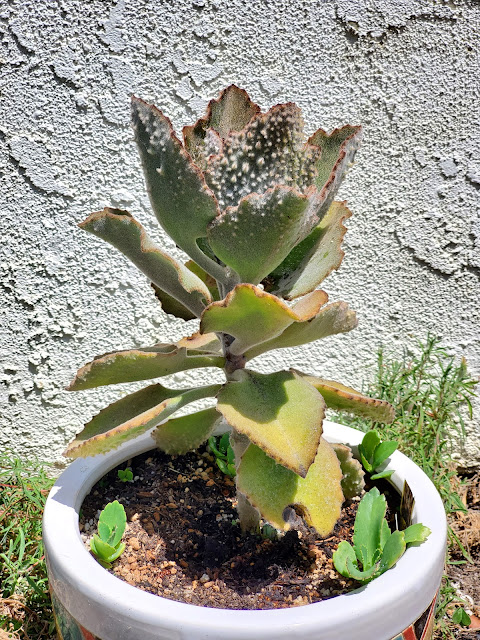I wrote about my largest plants, K. beharensis here, the furry Felt Plant, some varieties of which grow to tree size.
 |
| K beharensis Blue Slick rootstock regrown, with plantlets grown from planted leaf |
I bought one Blue Slick a couple of years ago, and when it lost its lower leaves I panicked. (I know now they usually lose the lower leaves.) I cut it up and planted the remaining leaves and the top separately and left the root+stalk in the pot. Every last part of that plant regrew. It's Kalanchoe's superpower!
The roots regenerated two good-looking branches bearing hairless leaves. Each leaf I planted grew a thicket of babies and the top rooted and grew a new plant.
 |
| K beharensis Blue Slick plantlets - they have fur |
The oddest thing is the leaves (which were, well, slick, not furry) grew furry babies. The new plants are almost a year old and have not lost their fur. It's possible that comes later but it's very odd. (Kalanchoe plants that reproduce by offshoots like this are clones. Their genetic material is identical to the parent plant. They don't just change varieties or hybridize like plants sometimes do when they produce seeds with other plants' pollen.)
Now I know that Blue Slick is going to grow huge like its cousin, I'll let it lose lower leaves and continue to grow.
One thing to remember about the deeply-indented leaves, especially furry ones: don't leave drops of water on top of them while they're in the sun. It burns the leaves and the scar never heals over.
I have another variety of K. beharensis called Fang. What appears to be the same thing was also sold to me under the variety name Flag. Both of these have the normal cupped, furry beharensis leaves but with canine-tooth-shaped protuberances on the underside. Since they carry their leaves tipped-up most of the time, it's possible to appreciate their striking looks even when they are quite small.
 |
| Kalanchoe beharensis "Fang" (or "Flag"). The smaller plants are baby Mother of Thousands that fell off Mother. |
 |
| Kalanchoe beharensis "Fang" in pot |
The last variety I have of this species is one I think is marketed as "Oak Leaf". The one I bought just said it was a beharensis, but it grew into this beautiful specimen. I'm guessing that it's an Oak Leaf since the leaves look that way. It's growing quite large but I don't know if it'll reach the tree-level heights that some K beharensis varieties can. If I've identified it correctly, it's a hybrid, Kalanchoe beharensis with K. millotii. (There are similar varieties, for example those sold as "Silver Strand" (which never give information on variety or hybrid status). This certainly isn't yet "densely branched" so I may change my mind when I see what the flowers look like, if any.)
 |
| Kalanchoe beharensis "Oak Leaf " (probably). (K tomentosa behind and to the left, K hildebrantia behind.) |
No comments:
Post a Comment